Competitive Strategy: PESTLE Analysis and Diversification Tool
VerifiedAdded on 2023/06/09
|9
|1686
|149
Report
AI Summary
This report delves into the application of strategic tools, specifically PESTLE analysis and diversification, to enhance business performance and gain a competitive edge. The report uses two companies from distinct industries, Sanofi, a pharmaceutical company, and Hitachi, a heavy machinery company, as case studies. The PESTLE analysis framework, encompassing political, economic, social, technological, legal, and environmental factors, is applied to Sanofi to identify operational challenges and areas for improvement. The report then explores diversification as a strategy tool, examining its different forms (horizontal, concentric, and conglomerate) and how Hitachi employs it to expand its product lines and market presence. The analysis highlights how Hitachi leverages technology, such as the Internet of Things (IoT), and a diversified distribution strategy to compete effectively in the market. The conclusion emphasizes the importance of these strategic tools for understanding the business environment and developing effective growth strategies, particularly in today's competitive landscape.
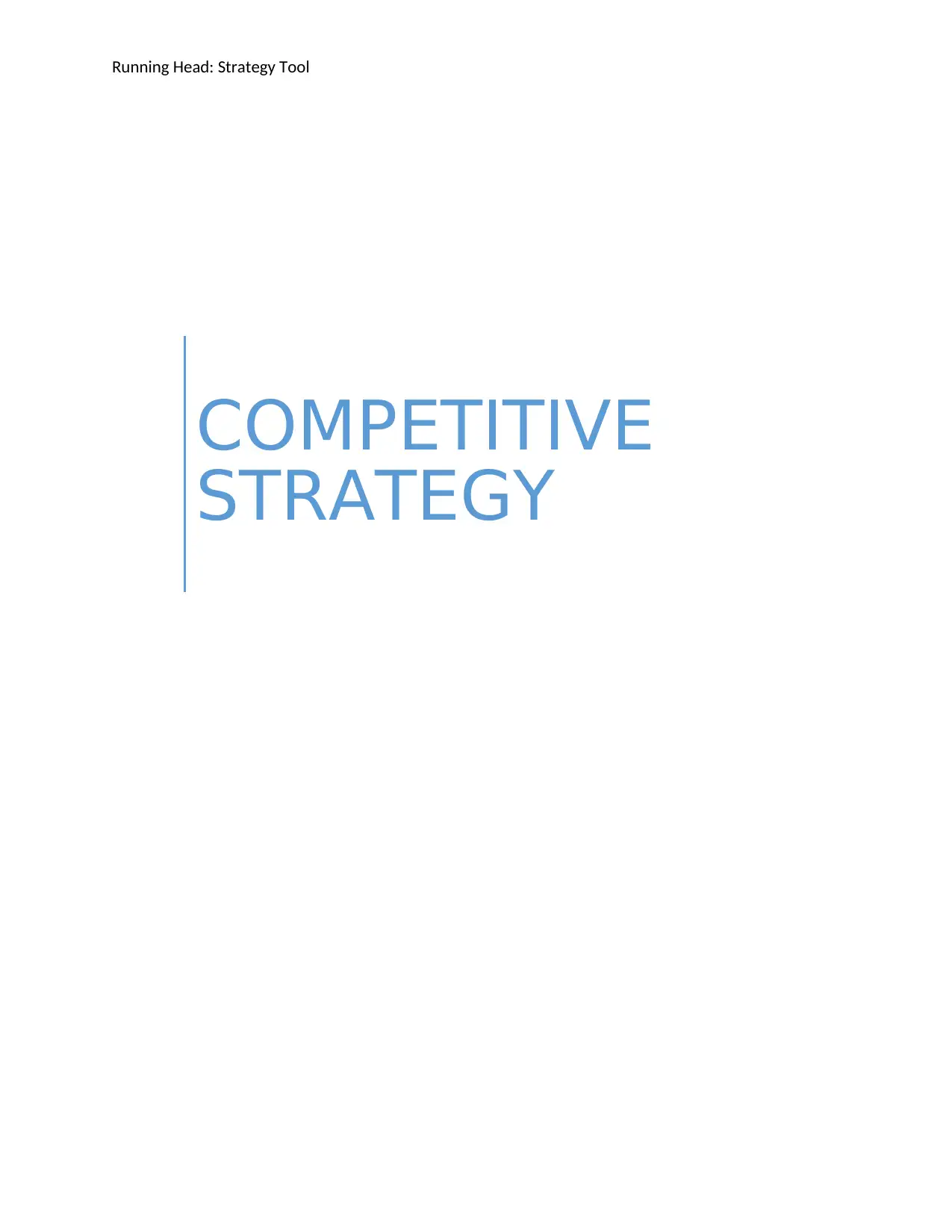
Running Head: Strategy Tool
COMPETITIVE
STRATEGY
COMPETITIVE
STRATEGY
Paraphrase This Document
Need a fresh take? Get an instant paraphrase of this document with our AI Paraphraser
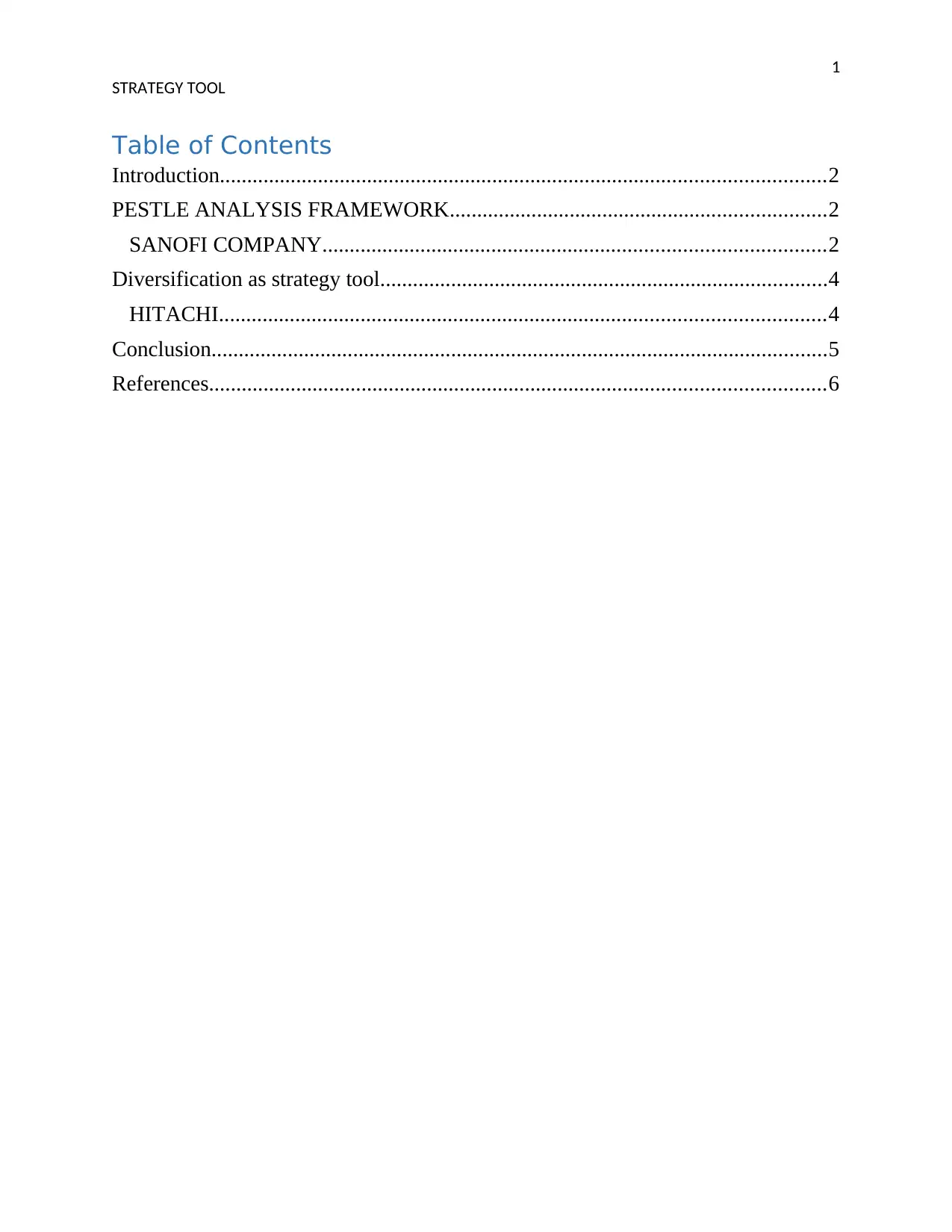
1
STRATEGY TOOL
Table of Contents
Introduction...............................................................................................................2
PESTLE ANALYSIS FRAMEWORK.....................................................................2
SANOFI COMPANY............................................................................................2
Diversification as strategy tool..................................................................................4
HITACHI...............................................................................................................4
Conclusion.................................................................................................................5
References.................................................................................................................6
STRATEGY TOOL
Table of Contents
Introduction...............................................................................................................2
PESTLE ANALYSIS FRAMEWORK.....................................................................2
SANOFI COMPANY............................................................................................2
Diversification as strategy tool..................................................................................4
HITACHI...............................................................................................................4
Conclusion.................................................................................................................5
References.................................................................................................................6
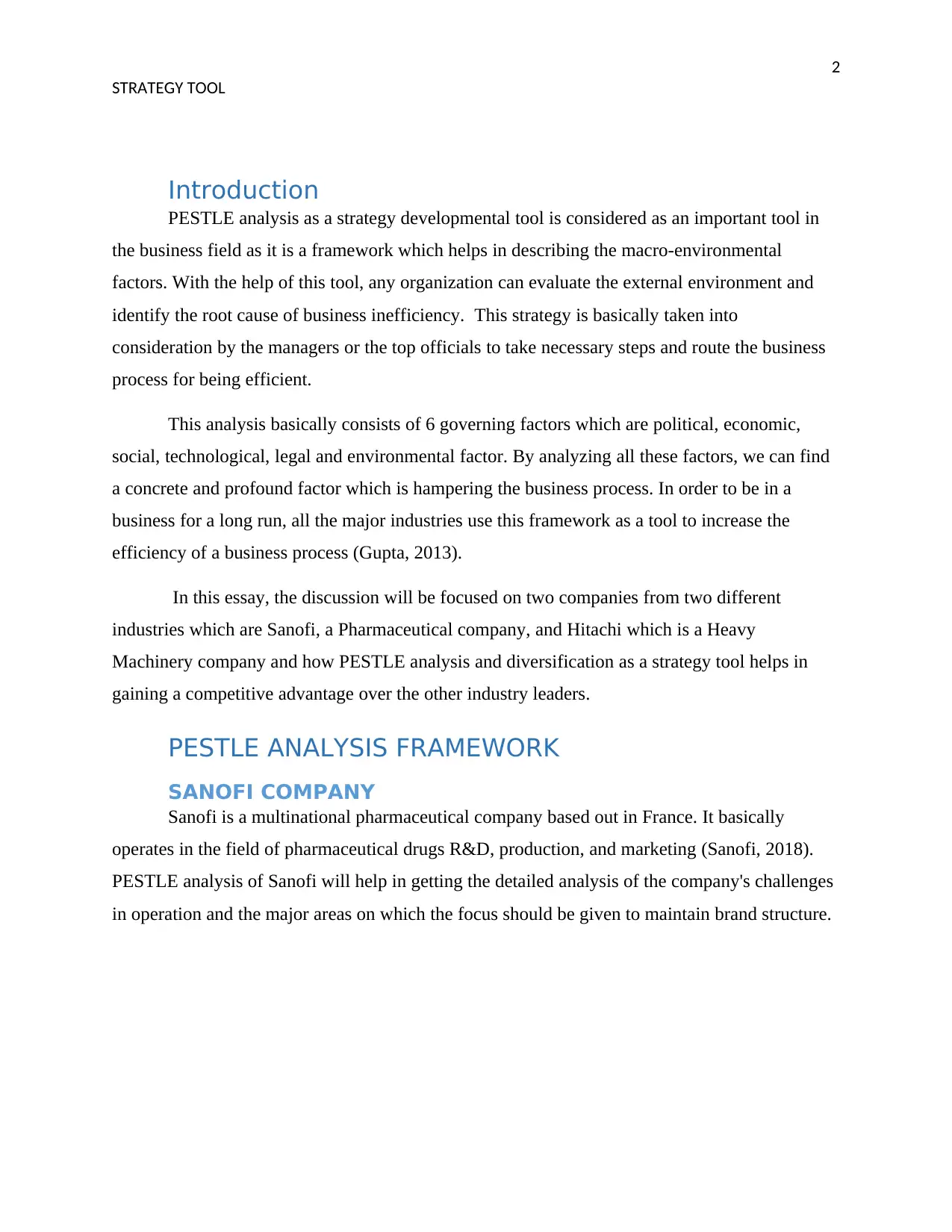
2
STRATEGY TOOL
Introduction
PESTLE analysis as a strategy developmental tool is considered as an important tool in
the business field as it is a framework which helps in describing the macro-environmental
factors. With the help of this tool, any organization can evaluate the external environment and
identify the root cause of business inefficiency. This strategy is basically taken into
consideration by the managers or the top officials to take necessary steps and route the business
process for being efficient.
This analysis basically consists of 6 governing factors which are political, economic,
social, technological, legal and environmental factor. By analyzing all these factors, we can find
a concrete and profound factor which is hampering the business process. In order to be in a
business for a long run, all the major industries use this framework as a tool to increase the
efficiency of a business process (Gupta, 2013).
In this essay, the discussion will be focused on two companies from two different
industries which are Sanofi, a Pharmaceutical company, and Hitachi which is a Heavy
Machinery company and how PESTLE analysis and diversification as a strategy tool helps in
gaining a competitive advantage over the other industry leaders.
PESTLE ANALYSIS FRAMEWORK
SANOFI COMPANY
Sanofi is a multinational pharmaceutical company based out in France. It basically
operates in the field of pharmaceutical drugs R&D, production, and marketing (Sanofi, 2018).
PESTLE analysis of Sanofi will help in getting the detailed analysis of the company's challenges
in operation and the major areas on which the focus should be given to maintain brand structure.
STRATEGY TOOL
Introduction
PESTLE analysis as a strategy developmental tool is considered as an important tool in
the business field as it is a framework which helps in describing the macro-environmental
factors. With the help of this tool, any organization can evaluate the external environment and
identify the root cause of business inefficiency. This strategy is basically taken into
consideration by the managers or the top officials to take necessary steps and route the business
process for being efficient.
This analysis basically consists of 6 governing factors which are political, economic,
social, technological, legal and environmental factor. By analyzing all these factors, we can find
a concrete and profound factor which is hampering the business process. In order to be in a
business for a long run, all the major industries use this framework as a tool to increase the
efficiency of a business process (Gupta, 2013).
In this essay, the discussion will be focused on two companies from two different
industries which are Sanofi, a Pharmaceutical company, and Hitachi which is a Heavy
Machinery company and how PESTLE analysis and diversification as a strategy tool helps in
gaining a competitive advantage over the other industry leaders.
PESTLE ANALYSIS FRAMEWORK
SANOFI COMPANY
Sanofi is a multinational pharmaceutical company based out in France. It basically
operates in the field of pharmaceutical drugs R&D, production, and marketing (Sanofi, 2018).
PESTLE analysis of Sanofi will help in getting the detailed analysis of the company's challenges
in operation and the major areas on which the focus should be given to maintain brand structure.
⊘ This is a preview!⊘
Do you want full access?
Subscribe today to unlock all pages.

Trusted by 1+ million students worldwide

3
STRATEGY TOOL
(Source: Business to You, 2016).
Political
Being exposed to the drug market, Sanofi as an organization faces challenges in tackling
several political risks. The risk associated with military invasion, standard safety regulations,
bureaucratic intervention are some of the associated risks on which focus should be given.
Economic:
There are several macro and microenvironmental factors that impact the business process
of any organization. By considering the economic factors like the rate of growth of a country's
economy, inflation, unemployment rates, financial market's efficiency it can be easy to evaluate
the growth trajectory. These factors can also be considered as a major player in increasing an
organizations efficiency and process (Johnson, 2016).
Social
The living standard of the people is diversified across all the borders. This diversification
and the way people perform activities impact the organization's culture. This is the key to how
STRATEGY TOOL
(Source: Business to You, 2016).
Political
Being exposed to the drug market, Sanofi as an organization faces challenges in tackling
several political risks. The risk associated with military invasion, standard safety regulations,
bureaucratic intervention are some of the associated risks on which focus should be given.
Economic:
There are several macro and microenvironmental factors that impact the business process
of any organization. By considering the economic factors like the rate of growth of a country's
economy, inflation, unemployment rates, financial market's efficiency it can be easy to evaluate
the growth trajectory. These factors can also be considered as a major player in increasing an
organizations efficiency and process (Johnson, 2016).
Social
The living standard of the people is diversified across all the borders. This diversification
and the way people perform activities impact the organization's culture. This is the key to how
Paraphrase This Document
Need a fresh take? Get an instant paraphrase of this document with our AI Paraphraser
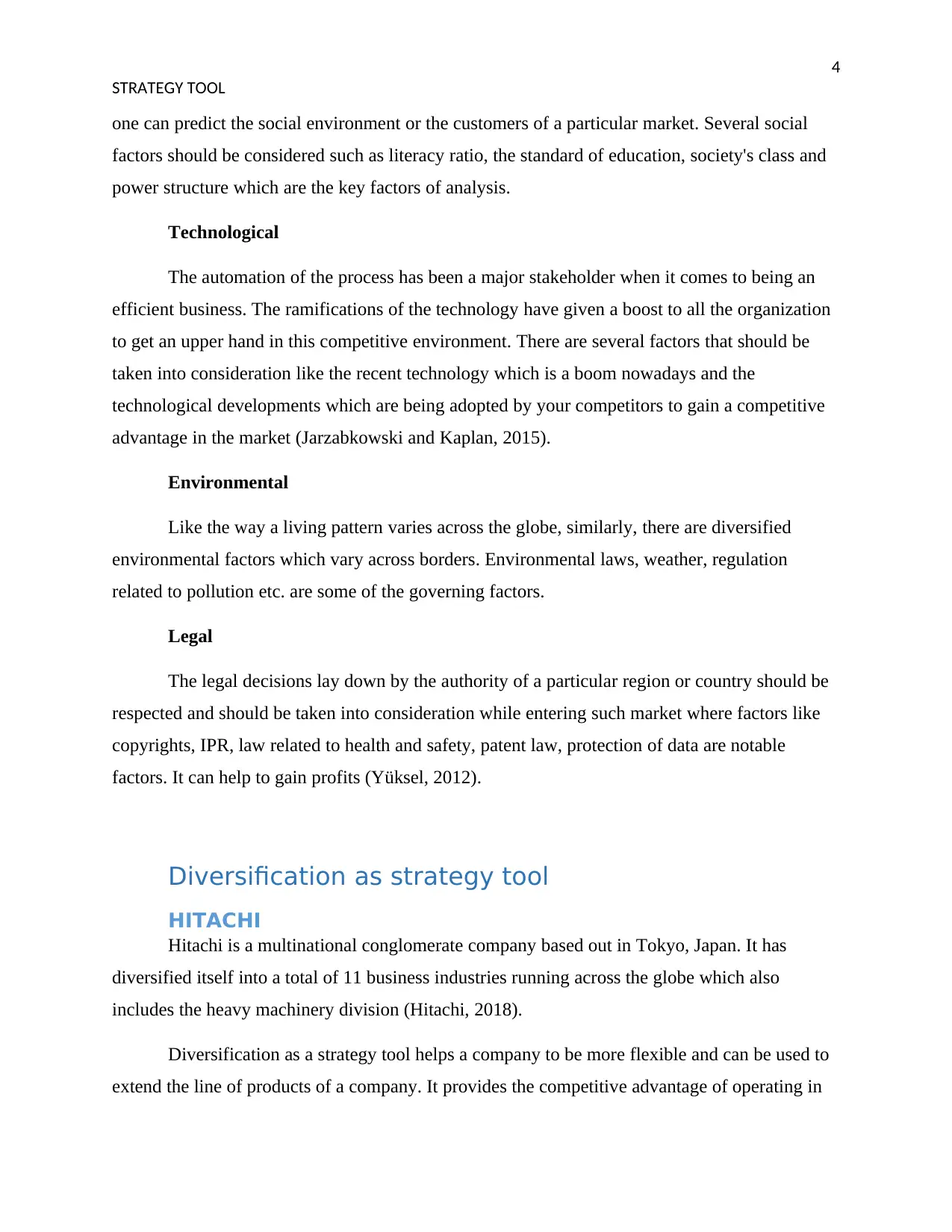
4
STRATEGY TOOL
one can predict the social environment or the customers of a particular market. Several social
factors should be considered such as literacy ratio, the standard of education, society's class and
power structure which are the key factors of analysis.
Technological
The automation of the process has been a major stakeholder when it comes to being an
efficient business. The ramifications of the technology have given a boost to all the organization
to get an upper hand in this competitive environment. There are several factors that should be
taken into consideration like the recent technology which is a boom nowadays and the
technological developments which are being adopted by your competitors to gain a competitive
advantage in the market (Jarzabkowski and Kaplan, 2015).
Environmental
Like the way a living pattern varies across the globe, similarly, there are diversified
environmental factors which vary across borders. Environmental laws, weather, regulation
related to pollution etc. are some of the governing factors.
Legal
The legal decisions lay down by the authority of a particular region or country should be
respected and should be taken into consideration while entering such market where factors like
copyrights, IPR, law related to health and safety, patent law, protection of data are notable
factors. It can help to gain profits (Yüksel, 2012).
Diversification as strategy tool
HITACHI
Hitachi is a multinational conglomerate company based out in Tokyo, Japan. It has
diversified itself into a total of 11 business industries running across the globe which also
includes the heavy machinery division (Hitachi, 2018).
Diversification as a strategy tool helps a company to be more flexible and can be used to
extend the line of products of a company. It provides the competitive advantage of operating in
STRATEGY TOOL
one can predict the social environment or the customers of a particular market. Several social
factors should be considered such as literacy ratio, the standard of education, society's class and
power structure which are the key factors of analysis.
Technological
The automation of the process has been a major stakeholder when it comes to being an
efficient business. The ramifications of the technology have given a boost to all the organization
to get an upper hand in this competitive environment. There are several factors that should be
taken into consideration like the recent technology which is a boom nowadays and the
technological developments which are being adopted by your competitors to gain a competitive
advantage in the market (Jarzabkowski and Kaplan, 2015).
Environmental
Like the way a living pattern varies across the globe, similarly, there are diversified
environmental factors which vary across borders. Environmental laws, weather, regulation
related to pollution etc. are some of the governing factors.
Legal
The legal decisions lay down by the authority of a particular region or country should be
respected and should be taken into consideration while entering such market where factors like
copyrights, IPR, law related to health and safety, patent law, protection of data are notable
factors. It can help to gain profits (Yüksel, 2012).
Diversification as strategy tool
HITACHI
Hitachi is a multinational conglomerate company based out in Tokyo, Japan. It has
diversified itself into a total of 11 business industries running across the globe which also
includes the heavy machinery division (Hitachi, 2018).
Diversification as a strategy tool helps a company to be more flexible and can be used to
extend the line of products of a company. It provides the competitive advantage of operating in
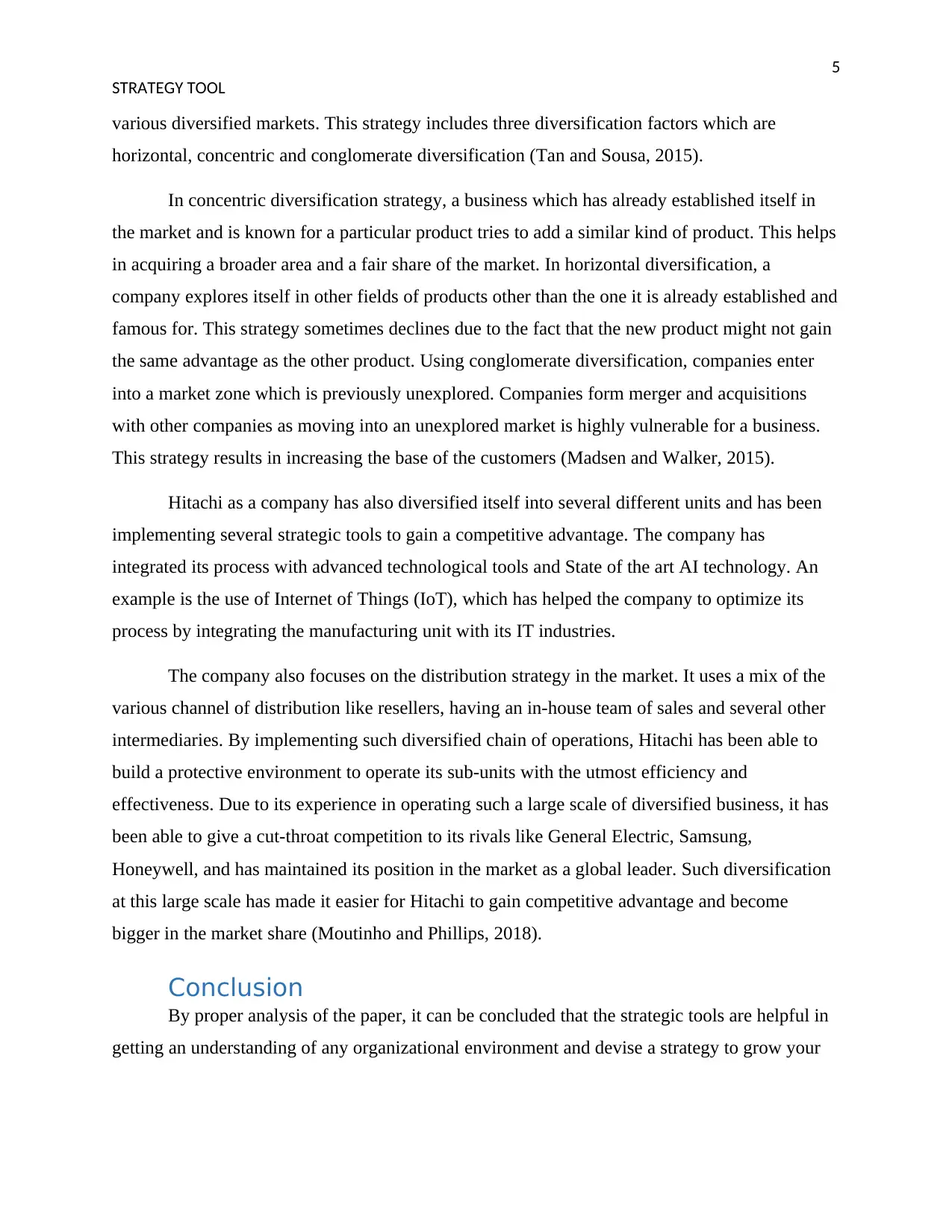
5
STRATEGY TOOL
various diversified markets. This strategy includes three diversification factors which are
horizontal, concentric and conglomerate diversification (Tan and Sousa, 2015).
In concentric diversification strategy, a business which has already established itself in
the market and is known for a particular product tries to add a similar kind of product. This helps
in acquiring a broader area and a fair share of the market. In horizontal diversification, a
company explores itself in other fields of products other than the one it is already established and
famous for. This strategy sometimes declines due to the fact that the new product might not gain
the same advantage as the other product. Using conglomerate diversification, companies enter
into a market zone which is previously unexplored. Companies form merger and acquisitions
with other companies as moving into an unexplored market is highly vulnerable for a business.
This strategy results in increasing the base of the customers (Madsen and Walker, 2015).
Hitachi as a company has also diversified itself into several different units and has been
implementing several strategic tools to gain a competitive advantage. The company has
integrated its process with advanced technological tools and State of the art AI technology. An
example is the use of Internet of Things (IoT), which has helped the company to optimize its
process by integrating the manufacturing unit with its IT industries.
The company also focuses on the distribution strategy in the market. It uses a mix of the
various channel of distribution like resellers, having an in-house team of sales and several other
intermediaries. By implementing such diversified chain of operations, Hitachi has been able to
build a protective environment to operate its sub-units with the utmost efficiency and
effectiveness. Due to its experience in operating such a large scale of diversified business, it has
been able to give a cut-throat competition to its rivals like General Electric, Samsung,
Honeywell, and has maintained its position in the market as a global leader. Such diversification
at this large scale has made it easier for Hitachi to gain competitive advantage and become
bigger in the market share (Moutinho and Phillips, 2018).
Conclusion
By proper analysis of the paper, it can be concluded that the strategic tools are helpful in
getting an understanding of any organizational environment and devise a strategy to grow your
STRATEGY TOOL
various diversified markets. This strategy includes three diversification factors which are
horizontal, concentric and conglomerate diversification (Tan and Sousa, 2015).
In concentric diversification strategy, a business which has already established itself in
the market and is known for a particular product tries to add a similar kind of product. This helps
in acquiring a broader area and a fair share of the market. In horizontal diversification, a
company explores itself in other fields of products other than the one it is already established and
famous for. This strategy sometimes declines due to the fact that the new product might not gain
the same advantage as the other product. Using conglomerate diversification, companies enter
into a market zone which is previously unexplored. Companies form merger and acquisitions
with other companies as moving into an unexplored market is highly vulnerable for a business.
This strategy results in increasing the base of the customers (Madsen and Walker, 2015).
Hitachi as a company has also diversified itself into several different units and has been
implementing several strategic tools to gain a competitive advantage. The company has
integrated its process with advanced technological tools and State of the art AI technology. An
example is the use of Internet of Things (IoT), which has helped the company to optimize its
process by integrating the manufacturing unit with its IT industries.
The company also focuses on the distribution strategy in the market. It uses a mix of the
various channel of distribution like resellers, having an in-house team of sales and several other
intermediaries. By implementing such diversified chain of operations, Hitachi has been able to
build a protective environment to operate its sub-units with the utmost efficiency and
effectiveness. Due to its experience in operating such a large scale of diversified business, it has
been able to give a cut-throat competition to its rivals like General Electric, Samsung,
Honeywell, and has maintained its position in the market as a global leader. Such diversification
at this large scale has made it easier for Hitachi to gain competitive advantage and become
bigger in the market share (Moutinho and Phillips, 2018).
Conclusion
By proper analysis of the paper, it can be concluded that the strategic tools are helpful in
getting an understanding of any organizational environment and devise a strategy to grow your
⊘ This is a preview!⊘
Do you want full access?
Subscribe today to unlock all pages.

Trusted by 1+ million students worldwide

6
STRATEGY TOOL
business more and more. Once an organization is able to capitalize and utilize the tool, it can
make the most out of any business.
On one hand, PESTLE analysis as a tool gives an insight of the six different external
factors that the marketers should consider while analyzing macro-environmental factors that may
affect the business process. On the other hand, diversification as a tool can be used to implement
a strategy to diversify a business process and enter into a new market wherein the company
doesn't operate presently.
In the present scenario, where every company is entering into the market with its chain of
products, it is important that this checkpoints or tools should be considered by Sanofi and
Hitachi. This will not only help them in gaining a competitive advantage but also help them in
acquiring a larger portion of worldwide market share.
STRATEGY TOOL
business more and more. Once an organization is able to capitalize and utilize the tool, it can
make the most out of any business.
On one hand, PESTLE analysis as a tool gives an insight of the six different external
factors that the marketers should consider while analyzing macro-environmental factors that may
affect the business process. On the other hand, diversification as a tool can be used to implement
a strategy to diversify a business process and enter into a new market wherein the company
doesn't operate presently.
In the present scenario, where every company is entering into the market with its chain of
products, it is important that this checkpoints or tools should be considered by Sanofi and
Hitachi. This will not only help them in gaining a competitive advantage but also help them in
acquiring a larger portion of worldwide market share.
Paraphrase This Document
Need a fresh take? Get an instant paraphrase of this document with our AI Paraphraser
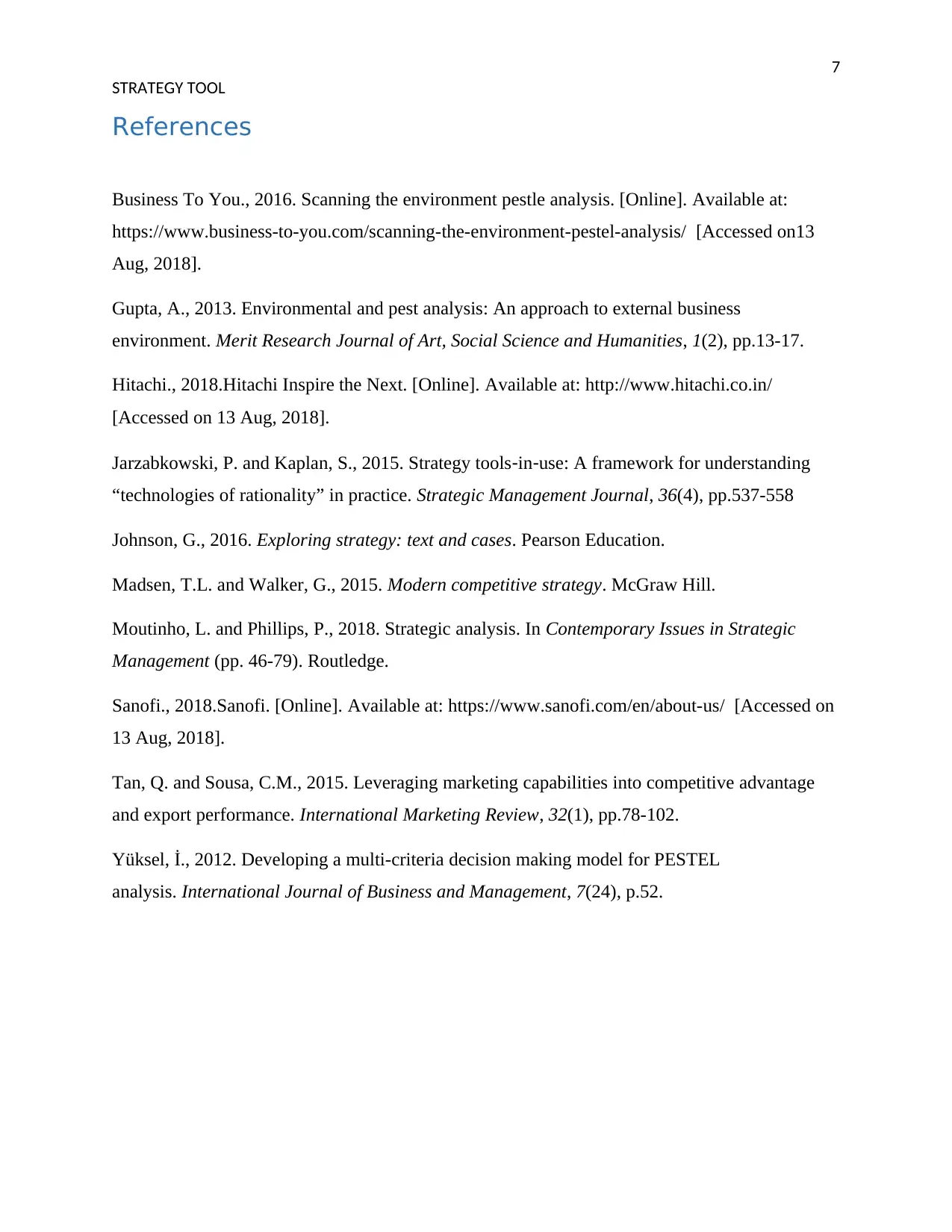
7
STRATEGY TOOL
References
Business To You., 2016. Scanning the environment pestle analysis. [Online]. Available at:
https://www.business-to-you.com/scanning-the-environment-pestel-analysis/ [Accessed on13
Aug, 2018].
Gupta, A., 2013. Environmental and pest analysis: An approach to external business
environment. Merit Research Journal of Art, Social Science and Humanities, 1(2), pp.13-17.
Hitachi., 2018.Hitachi Inspire the Next. [Online]. Available at: http://www.hitachi.co.in/
[Accessed on 13 Aug, 2018].
Jarzabkowski, P. and Kaplan, S., 2015. Strategy tools‐in‐use: A framework for understanding
“technologies of rationality” in practice. Strategic Management Journal, 36(4), pp.537-558
Johnson, G., 2016. Exploring strategy: text and cases. Pearson Education.
Madsen, T.L. and Walker, G., 2015. Modern competitive strategy. McGraw Hill.
Moutinho, L. and Phillips, P., 2018. Strategic analysis. In Contemporary Issues in Strategic
Management (pp. 46-79). Routledge.
Sanofi., 2018.Sanofi. [Online]. Available at: https://www.sanofi.com/en/about-us/ [Accessed on
13 Aug, 2018].
Tan, Q. and Sousa, C.M., 2015. Leveraging marketing capabilities into competitive advantage
and export performance. International Marketing Review, 32(1), pp.78-102.
Yüksel, İ., 2012. Developing a multi-criteria decision making model for PESTEL
analysis. International Journal of Business and Management, 7(24), p.52.
STRATEGY TOOL
References
Business To You., 2016. Scanning the environment pestle analysis. [Online]. Available at:
https://www.business-to-you.com/scanning-the-environment-pestel-analysis/ [Accessed on13
Aug, 2018].
Gupta, A., 2013. Environmental and pest analysis: An approach to external business
environment. Merit Research Journal of Art, Social Science and Humanities, 1(2), pp.13-17.
Hitachi., 2018.Hitachi Inspire the Next. [Online]. Available at: http://www.hitachi.co.in/
[Accessed on 13 Aug, 2018].
Jarzabkowski, P. and Kaplan, S., 2015. Strategy tools‐in‐use: A framework for understanding
“technologies of rationality” in practice. Strategic Management Journal, 36(4), pp.537-558
Johnson, G., 2016. Exploring strategy: text and cases. Pearson Education.
Madsen, T.L. and Walker, G., 2015. Modern competitive strategy. McGraw Hill.
Moutinho, L. and Phillips, P., 2018. Strategic analysis. In Contemporary Issues in Strategic
Management (pp. 46-79). Routledge.
Sanofi., 2018.Sanofi. [Online]. Available at: https://www.sanofi.com/en/about-us/ [Accessed on
13 Aug, 2018].
Tan, Q. and Sousa, C.M., 2015. Leveraging marketing capabilities into competitive advantage
and export performance. International Marketing Review, 32(1), pp.78-102.
Yüksel, İ., 2012. Developing a multi-criteria decision making model for PESTEL
analysis. International Journal of Business and Management, 7(24), p.52.

8
STRATEGY TOOL
STRATEGY TOOL
⊘ This is a preview!⊘
Do you want full access?
Subscribe today to unlock all pages.

Trusted by 1+ million students worldwide
1 out of 9
Related Documents
Your All-in-One AI-Powered Toolkit for Academic Success.
+13062052269
info@desklib.com
Available 24*7 on WhatsApp / Email
![[object Object]](/_next/static/media/star-bottom.7253800d.svg)
Unlock your academic potential
Copyright © 2020–2025 A2Z Services. All Rights Reserved. Developed and managed by ZUCOL.





